
Gastropods, commonly known as slugs and snails, belong to a large taxonomic class of invertebrates within the phylum Mollusca called Gastropoda.

Bivalvia, in previous centuries referred to as the Lamellibranchiata and Pelecypoda, is a class of marine and freshwater molluscs that have laterally compressed bodies enclosed by a shell consisting of two hinged parts. As a group, bivalves have no head and they lack some usual molluscan organs, like the radula and the odontophore. The class includes the clams, oysters, cockles, mussels, scallops, and numerous other families that live in saltwater, as well as a number of families that live in freshwater. The majority are filter feeders. The gills have evolved into ctenidia, specialised organs for feeding and breathing. Most bivalves bury themselves in sediment, where they are relatively safe from predation. Others lie on the sea floor or attach themselves to rocks or other hard surfaces. Some bivalves, such as the scallops and file shells, can swim. Shipworms bore into wood, clay, or stone and live inside these substances.

Scallop is a common name that encompasses various species of marine bivalve mollusks in the taxonomic family Pectinidae, the scallops. However, the common name "scallop" is also sometimes applied to species in other closely related families within the superfamily Pectinoidea, which also includes the thorny oysters.
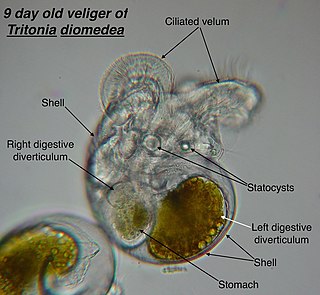
A veliger is the planktonic larva of many kinds of sea snails and freshwater snails, as well as most bivalve molluscs (clams) and tusk shells.
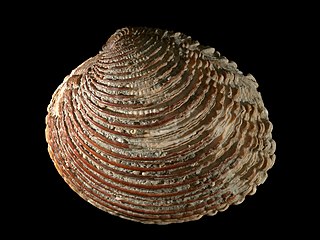
The Veneridae or venerids, common name: Venus clams, are a very large family of minute to large, saltwater clams, marine bivalve molluscs. Over 500 living species of venerid bivalves are known, most of which are edible, and many of which are exploited as food sources.

The Pteriomorphia comprise a subclass of saltwater clams, marine bivalve molluscs. It contains several major orders, including the Arcida, Ostreida, Pectinida, Limida, Mytilida, and Pteriida. It also contains some extinct and probably basal families, such as the Evyanidae, Colpomyidae, Bakevelliidae, Cassianellidae, and Lithiotidae.
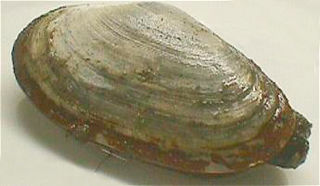
Myida is an order of saltwater and freshwater clams, marine and freshwater bivalve molluscs in the subclass Heterodonta. The order includes such bivalves as soft-shell clams, geoducks and shipworms.
Sphaerium nucleus is a freshwater bivalve of the family Sphaeriidae. It has been often confused with Sphaerium corneum and is consequently quite poorly known.
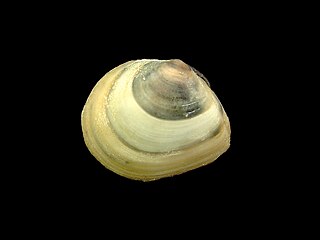
Limecola balthica, commonly called the Baltic macoma, Baltic clam or Baltic tellin, is a small saltwater clam, a marine bivalve mollusk in the family Tellinidae.

The ocean quahog is a species of edible clam, a marine bivalve mollusk in the family Arcticidae. This species is native to the North Atlantic Ocean, and it is harvested commercially as a food source. This species is also known by a number of different common names, including Icelandic cyprine, mahogany clam, mahogany quahog, black quahog, and black clam.
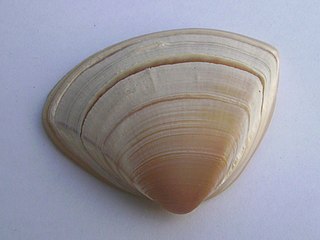
Crassula aequilatera, known as the triangle shell, is a surf clam, a moderately large marine bivalve mollusc in the family Mactridae.

Mollusca is the second-largest phylum of invertebrate animals, after Arthropoda; members are known as molluscs or mollusks. Around 76,000 extant species of molluscs are recognized. The number of fossil species is estimated between 60,000 and 100,000 additional species. The proportion of undescribed species is very high. Many taxa remain poorly studied.

Juliidae, common name the bivalved gastropods, is a family of minute sea snails, marine gastropod mollusks or micromollusks in the superfamily Oxynooidea, an opisthobranch group.

Fordilla is an extinct genus of early bivalves, one of two genera in the extinct family Fordillidae. The genus is known solely from Early Cambrian fossils found in North America, Greenland, Europe, the Middle East, and Asia. The genus currently contains three described species, Fordilla germanica, Fordilla sibirica, and the type species Fordilla troyensis.
Monopleura is a genus of saltwater clams, marine bivalve mollusks in the family Monopleuridae. These fossils have been dated back to the Cretaceous Period.

Lamelliconcha circinata, common name the "purple venus clam", is a species of bivalve mollusc in the family Veneridae, the venus clams. This species can be found around the coasts of the islands in the West Indies.
Pojetaia is an extinct genus of early bivalves, one of two genera in the extinct family Fordillidae. The genus is known solely from Early to Middle Cambrian fossils found in North America, Greenland, Europe, North Africa, Asia, and Australia. The genus currently contains two accepted species, Pojetaia runnegari, the type species, and Pojetaia sarhroensis, though up to seven species have been proposed. The genera Buluniella, Jellia, and Oryzoconcha are all considered synonyms of Pojetaia.
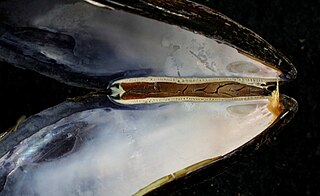
A hinge ligament is a crucial part of the anatomical structure of a bivalve shell, i.e. the shell of a bivalve mollusk. The shell of a bivalve has two valves and these are joined by the ligament at the dorsal edge of the shell. The ligament is made of a strong, flexible and elastic, fibrous, proteinaceous material which is usually pale brown, dark brown or black in color.

Laternula is a genus of bivalves belonging to the family Laternulidae.

Pinna muricata is a species of bivalves belonging to the family Pinnidae.
















